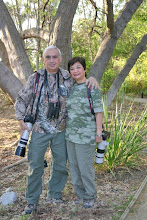And as it turned out, all that anxiety for nothing.
The planks used for boarding and disembarking from the motorized boats were steady enough for me and my heavy load. Besides there were even improvised handrails and helpful crewmen. What about the high tide? The deepest I got submerged in was up to my ankles only.
We arrived at the Olango Island Bird Sanctuary around 7:30 am. While registering, we asked the person in charge if Boy the local guide (who was heavily recommended by friends who had been here before) will be coming. To our disappointment we learned that he won't be able to make it since he had to take his child to the hospital. Thankfully, Jun, another employee of the DENR (Department of Energy and Natural Resources), was available and willing to show us where the birds are. Since it will only be me who will do the bird photography, we agreed that Cynthia will just stay at the observation deck to relax and enjoy the scenery.
The tide was still very low at that time of day and the birds were only specks in the horizon. I was initially wearing a long-sleeved shirt (to protect my arms from sunburn) but by simply walking from the Nature Center to the observation deck my shirt was sopping wet from my perspiration. I had no choice but to take the darn thing off. Half-naked I followed Jun to the haunt of the waders. For more than three hours, we sloshed through the shallow sea waters stopping every so often when a bird appears within photographic distance, roughly about 20 meters or so. The sun was shining fiercely and since the expanse offered no cover at all, I got burned badly. Apparently the sunblock my wife smeared all over my torso and arms didn't do much of a job.
At around 11 in the morning, the tide came rushing in. So did the migrant birds. I only had a short window of time before the swift flowing waters drove the waders farther away. Frantic shooting became the norm. Then all of a sudden the birds were gone.
Once again I waded through ankle deep waters and my skin tanned to a degree of redness that was not unlike that of an American Indian. Red Seawalker should have been my name then. Nonetheless, I was all smiles knowing that through my sloshing and burning I have harvested five lifers that morning.
Lifer # 1
 |
| Greater Sand Plover |
 |
| Great Knot |
 |
| Eurasian Curlew |
 |
| Terek Sandpiper |
 |
| Little Tern |





No comments:
Post a Comment